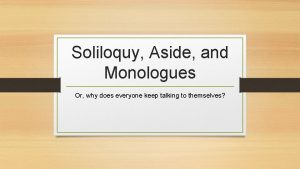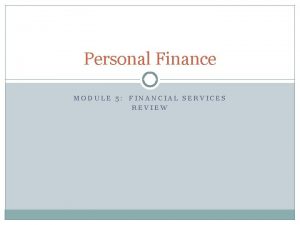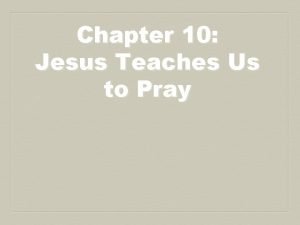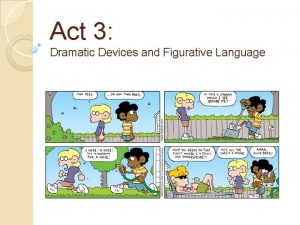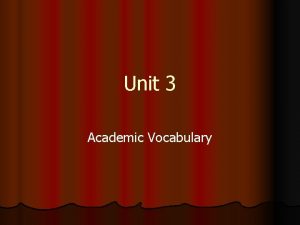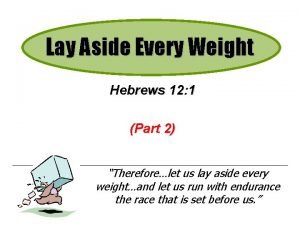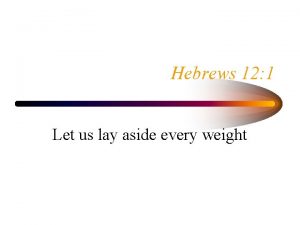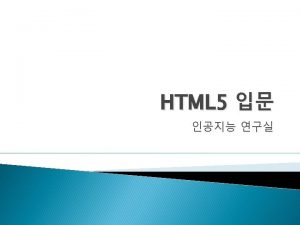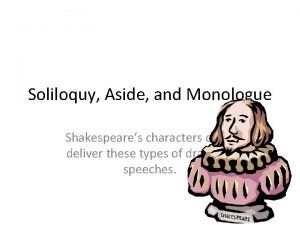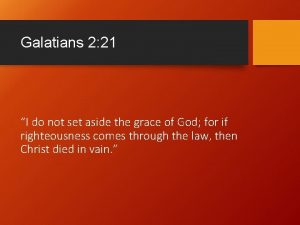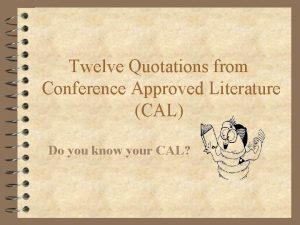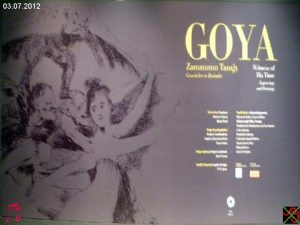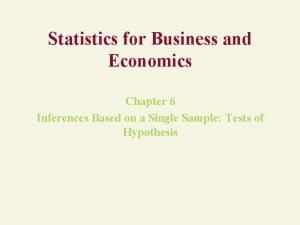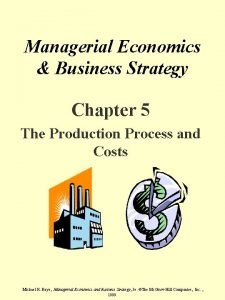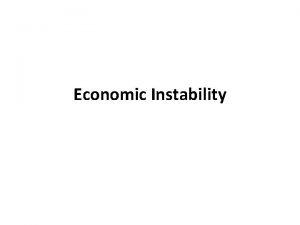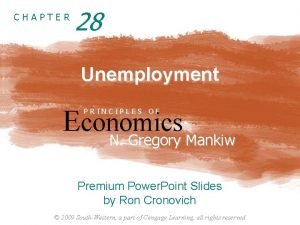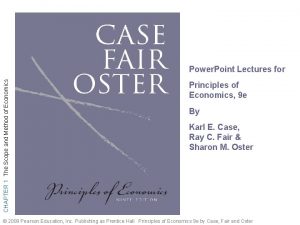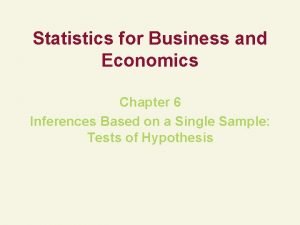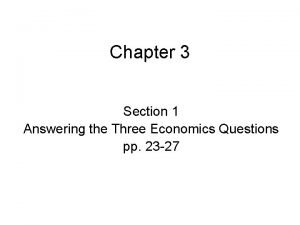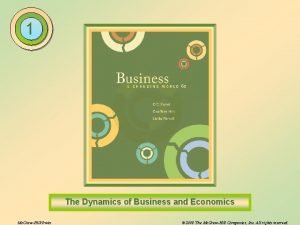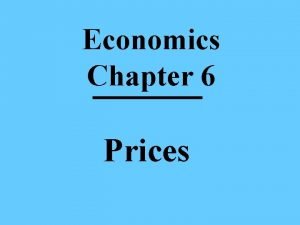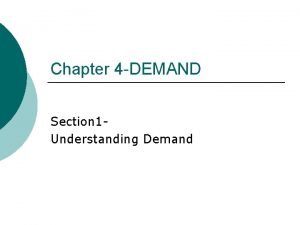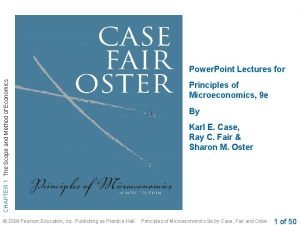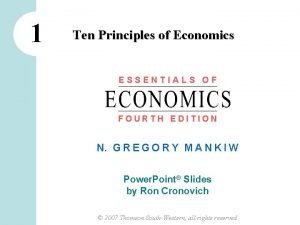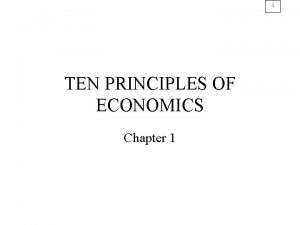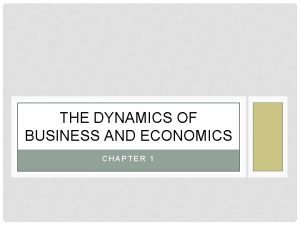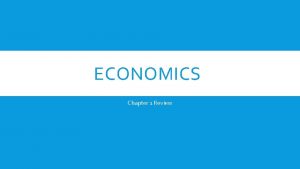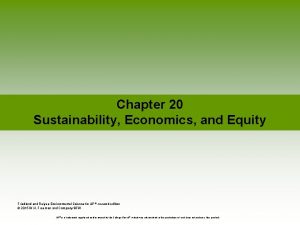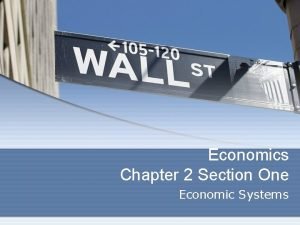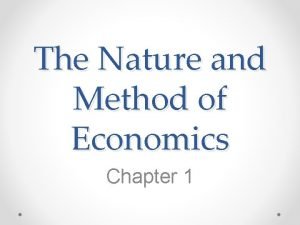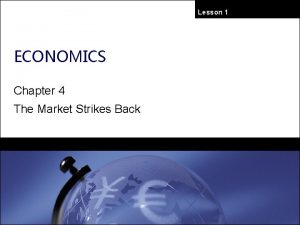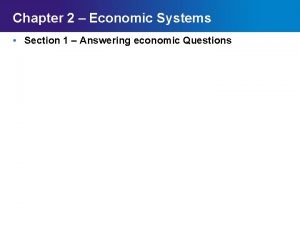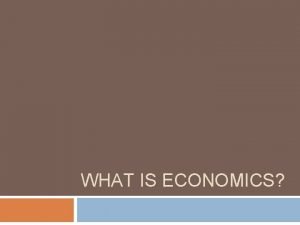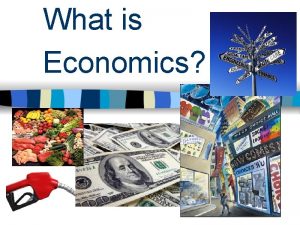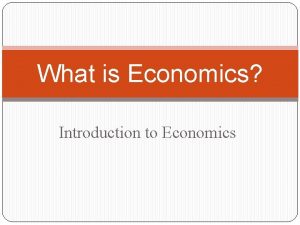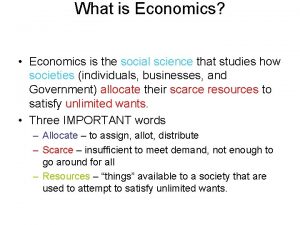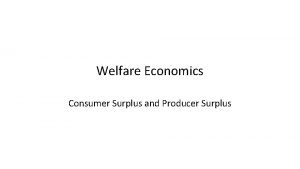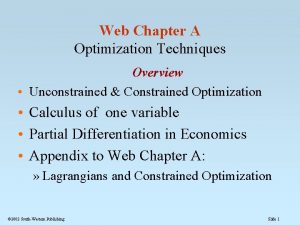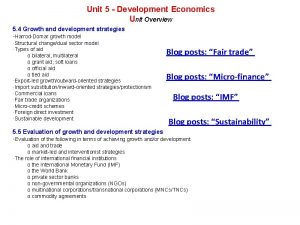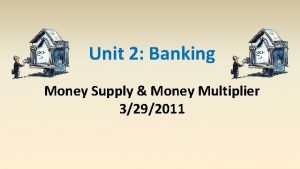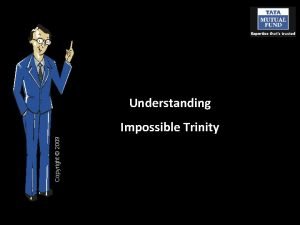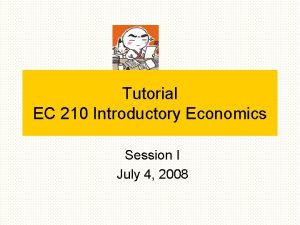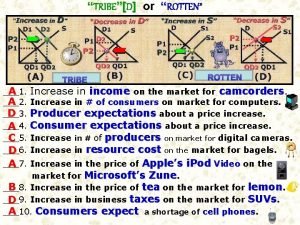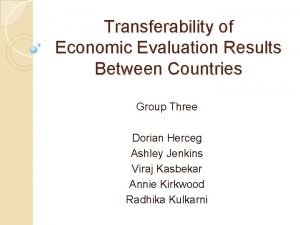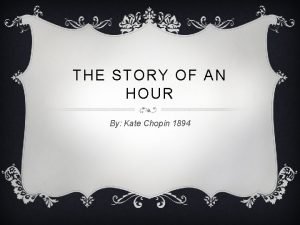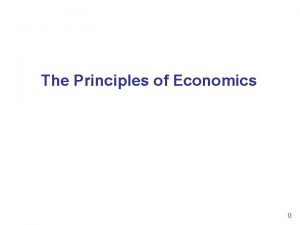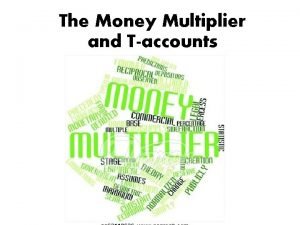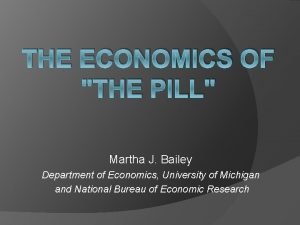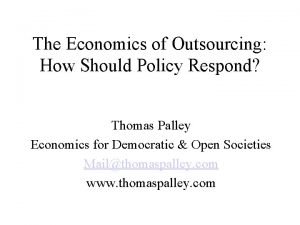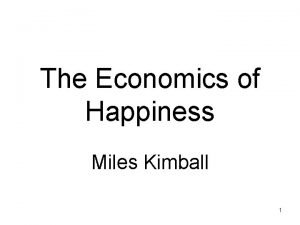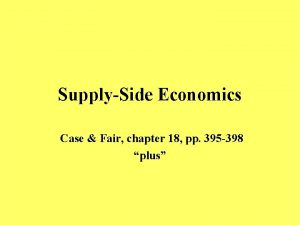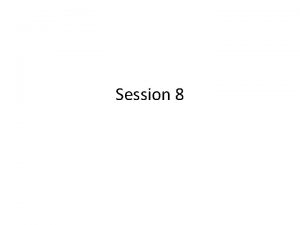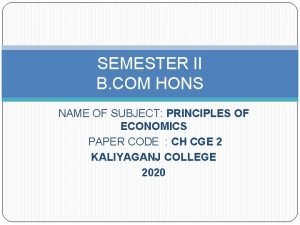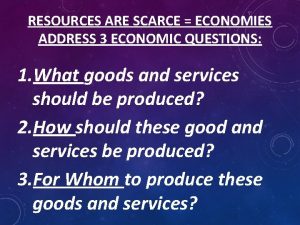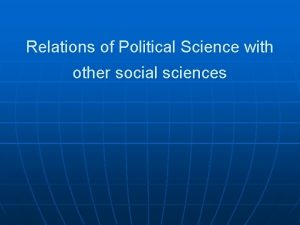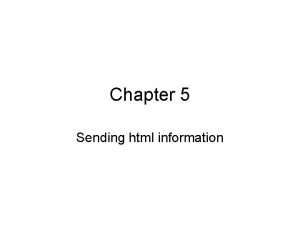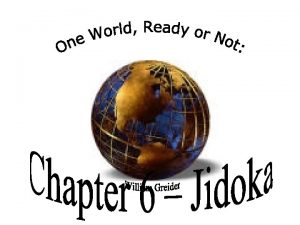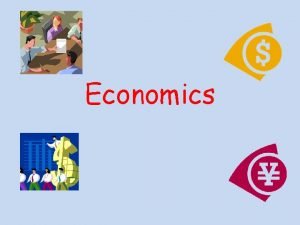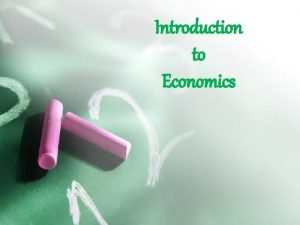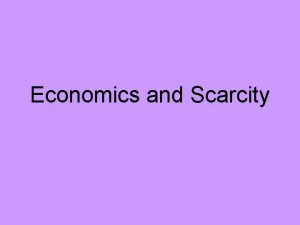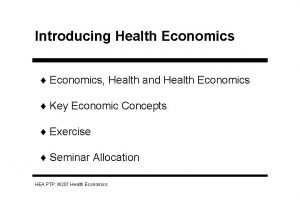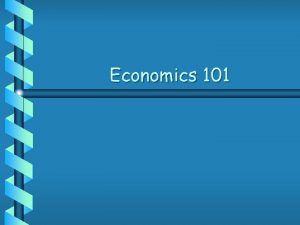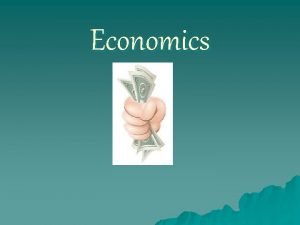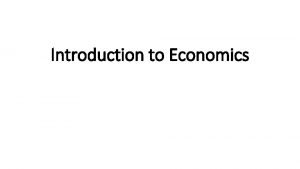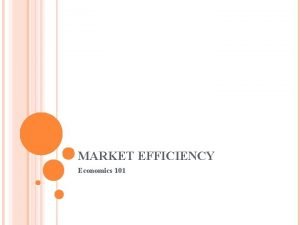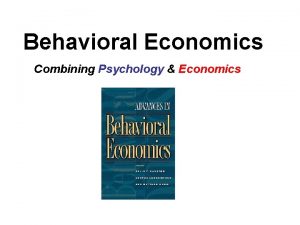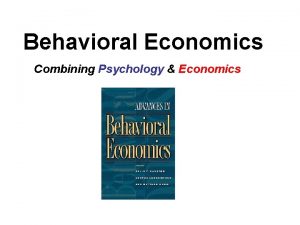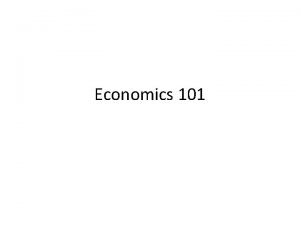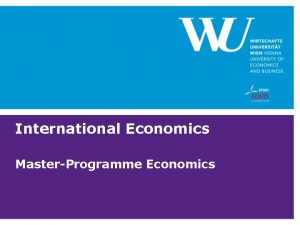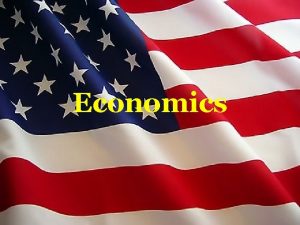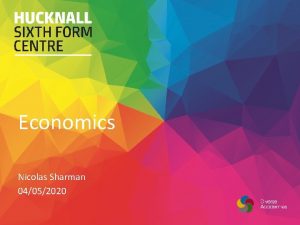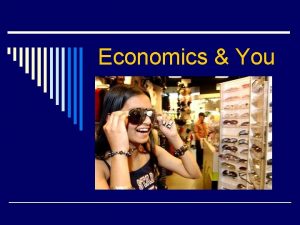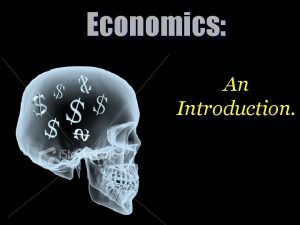CHAPTER 1 What is Economics a Aside from
























































































- Slides: 88

CHAPTER 1 What is Economics? a “Aside from Religion, economics is perhaps the most pervasive yet least understood force in American life. ” Jon Meacham – Editor, Newsweek Magazine September 24, 2007

After studying this chapter, you will be able to: w Define economics and distinguish between w microeconomics and macroeconomics Explain the two big questions of economics § What are the consequences of choices (what, how, and § for whom)? Does self-interest unintentionally promote social interest? w Explain the key ideas that define the economic way of thinking w Explain how economists go about their work as social scientists and policy advisers w Describe the jobs available for an economics major

Economic Science is Young w Economics as a science is just over 200 years old. w Adam Smith’s The Wealth of Nations (1776) marks the beginning of our subject. w Compared to physics and chemistry, however, we’re newcomers.

Economics and Choice w Economics is the social science that studies the choices that individuals, businesses, governments, and entire societies make as they cope with scarcity and the incentives that influence and reconcile those choices. w Economics is sometimes called the science of choice — the science that explains the choices that people make and predicts how choices change as circumstances change.

Definition of Economics § All economic questions arise because we want more than we can get. § Our inability to satisfy all our wants is called scarcity. § Because we face scarcity, we must make choices. § The choices we make depend on the incentives we face. § An incentive is a reward that encourages an action or a penalty that discourages an action.

Definition of Economics § Economics divides in two main parts: ■ Microeconomics ■ Macroeconomics

Definition of Economics § Microeconomics is the study of choices that individuals and businesses make, the way those choices interact in markets, and the influence of governments. § An example of a microeconomic question is: Why are people downloading more movies? Would a tax on downloads change the number of movies downloaded? § Macroeconomics is the study of the performance of the national and global economies. § An example of a macroeconomic question is: Why does the unemployment rate fluctuate?

Two Big Economic Questions § Two big questions summarize the scope of economics: ■ How do choices end up determining what, how, and for whom goods and services get produced? ■ When do choices made in the pursuit of self-interest also promote the social interest?

Two Big Economic Questions w What, How, and For Whom? § Goods and services are the objects that people value and produce to satisfy human wants. w What? § In the United States, agriculture accounts for less than 1 percent of total production, manufactured goods for 19 percent, and services for 80 percent. § In low-income Ethiopia, agriculture accounts for 36 percent of total production, manufactured goods for 17 percent, and services for 47 percent.

Two Big Economic Questions § Figure 1. 1 shows these numbers for the United States, China, and Ethiopia. § What determines these patterns of production? § How do choices end up determining the quantity of each item produced in the United States and around the world?

Two Big Economic Questions w How? ■ ■ § Goods and services are produced by using productive resources that economists call factors of production. § Factors of production are grouped into four categories: Land Labor Capital Entrepreneurship

Two Big Economic Questions § The “gifts of nature” that we use to produce goods and services are land. § The work time and work effort that people devote to producing goods and services is labor. § The quality of labor depends on human capital, which is the knowledge and skill that people obtain from education, on-the-job training, and work experience. § The tools, instruments, machines, buildings, and other constructions that businesses use to produce goods and services are capital. § The human resource that organizes land, labor, and capital is entrepreneurship.

Two Big Economic Questions § Figure 1. 2 shows a measure of the growth of human capital in the United States since 1900—the percentage of the population that has completed different levels of education. § Economics explains these trends.

Two Big Economic Questions w For Whom? § Who gets the goods and services depends on the incomes that people earn. ■ Land earns rent. ■ Labor earns wages. ■ Capital earns interest. ■ Entrepreneurship earns profit.

Two Big Economic Questions w Do Choices Made in the Pursuit of Self-Interest also Promote the Social Interest? § Every day, 325 million Americans and 7. 4 billion people in other countries make economic choices that result in what, how, and for whom goods and services are produced. § These choices are made by people who are pursuing their self-interest. § Are they promoting the social interest?

Two Big Economic Questions § Self-Interest § You make choices that are in your selfinterest—choices that you think are best for you. § Social Interest § Choices that are best for society as a whole are said to be in the social interest. § Social interest has two dimensions: efficiency and fair shares.

Two Big Economic Questions § Efficiency and Social Interest § Resource use is efficient if it is not possible to make someone better off without making someone else worse off. § Fair Shares and Social Interest § The idea that the social interest requires “fair shares” is a deeply held one. § But what is a fair share?

Two Big Economic Questions w Questions about the social interest are hard ones to answer and they generate discussion, debate, and disagreement. § Four topics that generate discussion and that illustrate tension between selfinterest and social interest are: ■ Globalization ■ Information-age monopolies ■ Climate change ■ Financial instability

Two Big Economic Questions § Globalization means the expansion of international trade, borrowing and lending, and investment. § Globalization is in the self-interest of consumers who buy low-cost imported goods and services. § Globalization is also in the self-interest of the multinational firms that produce in low-cost regions and sell in high-price regions. § But is globalization in the self-interest of lowwage workers in other countries and U. S. firms that can’t compete with low-cost imports? § Is globalization in the social interest?

Two Big Economic Questions § Information-Age Monopolies § The technological change of the past forty years has been called the Information Revolution. § The information revolution has clearly served your self-interest: It has provided your cellphone, laptop, loads of handy applications, and the Internet. § It has also served the self-interest of Bill Gates of Microsoft and Gordon Moore of Intel, both of whom have seen their wealth soar. § But did the information revolution serve the social interest?

Two Big Economic Questions § Climate Change w Climate change is a huge political issue today. w Every serious political leader is acutely aware of the problem and of the popularity of having proposals that might lower carbon emissions. w Burning fossil fuels to generate electricity and to power airplanes, automobiles, and trucks pours a staggering 28 billion tons— 4 tons person—of carbon dioxide into the atmosphere each year.

Two Big Economic Questions w Two thirds of the world’s carbon emissions comes from the United States, China, the European Union, Russia, and India. w The fastest growing emissions are coming from India and China. w The amount of global warming caused by economic activity and its effects are uncertain, but the emissions continue to grow and pose huge risks.

Two Big Economic Questions w Every day, when you make self-interested choices to use electricity and gasoline, you contribute to carbon emissions. w You leave your carbon footprint. § You can lessen your carbon footprint by walking, riding a bike, taking a cold shower, or planting a tree. § But can each one of us be relied upon to make decisions that affect the Earth’s carbondioxide concentration in the social interest? w Can governments change the incentives we face so that our self-interested choices are also in the social interest?

Two Big Economic Questions § Economic Instability w In 2008, banks were in trouble. They had made loans that borrowers couldn’t repay and they were holding securities the values of which had crashed. w Banks’ choices to take deposits and make loans are made in self-interest, but does this lending and borrowing serve the social interest? w Do banks lend too much in the pursuit of profit?

Economic Way of Thinking ■ ■ ■ § Six key ideas define the economic way of thinking: A choice is a tradeoff. People make rational choices by comparing benefits and costs. Benefit is what you gain from something. Cost is what you must give up to get something. Most choices are “how-much” choices made at the margin. Choices respond to incentives.

Economic Way of Thinking w A Choice Is a Tradeoff § The economic way of thinking places scarcity and its implication, choice, at center stage. § You can think about every choice as a tradeoff —an exchange—giving up one thing to get something else. § On Saturday night, will you study or have fun? § You can’t study and have fun at the same time, so you must make a choice. § Whatever you choose, you could have chosen something else. Your choice is a tradeoff.

Economic Way of Thinking w Making a Rational Choice § A rational choice is one that compares costs and benefits and achieves the greatest benefit over cost for the person making the choice. § Only the wants of the person making a choice are relevant to determine its rationality. § The idea of rational choice provides an answer to the first question: What goods and services will be produced and in what quantities? § The answer is: Those that people rationally choose to buy!

The Economic Way of Thinking w How do people choose rationally? w The answers turn on benefits and costs. w Benefit: What you Gain w The benefit of something is the gain or pleasure that it brings and is determined by preferences w Preferences are what a person likes and dislikes and the intensity of those feelings.

The Economic Way of Thinking w Cost: What you Must Give Up § The opportunity cost of something is the highest-valued alternative that must be given up to get it. § What is your opportunity cost of going to a live concert? § Opportunity cost has two components: § 1. The things you can’t afford to buy if you purchase the concert ticket. § 2. The things you can’t do with your time if you attend the concert.

The Economic Way of Thinking w How Much? Choosing at the Margin w You can allocate the next hour between studying and instant messaging your friends. w The choice is not all or nothing, but you must decide how many minutes to allocate to each activity. w To make this decision, you compare the benefit of a little bit more study time with its cost—you make your choice at the margin.

The Economic Way of Thinking § To make a choice at the margin, you evaluate the consequences of making incremental changes in the use of your time. § The benefit from pursuing an incremental increase in an activity is its marginal benefit. § The opportunity cost of pursuing an incremental increase in an activity is its marginal cost. § If the marginal benefit from an incremental increase in an activity exceeds its marginal cost, your rational choice is to do more of that activity.

The Economic Way of Thinking w Choices Respond to Incentives § A change in marginal cost or a change in marginal benefit changes the incentives that we face and leads us to change our choice. § The central idea of economics is that we can predict how choices will change by looking at changes in incentives. § Incentives are also the key to reconciling selfinterest and the social interest.

Economics: A Social Science and Policy Tool § Economist as Social Scientist § Economists distinguish between two types of statement: ■ Positive statements ■ Normative statements § A positive statement can be tested by checking it against facts. § A normative statement expresses an opinion and cannot be tested.

Economics: A Social Science and Policy Tool § Unscrambling Cause and Effect § The task of economic science is to discover positive statements that are consistent with what we observe in the world and that enable us to understand how the economic world works. § Economists create and test economic models. § An economic model is a description of some aspect of the economic world that includes only those features that are needed for the purpose at hand.

Economics: A Social Science and Policy Tool § A model is tested by comparing its predictions with the facts. § But testing an economic model is difficult, so economists also use: ■ Natural experiments ■ Statistical investigations ■ Economic experiments

Economics: A Social Science and Policy Tool § Economist as Policy Adviser § Economics is a toolkit for advising governments and businesses and for making personal decisions. § All the policy questions on which economists provide advice involve a blend of the positive and the normative. § Economics can’t help with the normative part— the goal. § But for a given goal, economics provides a method of evaluating alternative solutions— comparing marginal benefits and marginal costs.

Economic Science and Economic Policy w Economic science is the attempt to understand the economic world. Science makes predictions. w Economic policy is the attempt to improve the economic world. Policy makes prescriptions. w Policies made without science usually will not be very good.

Objectives of Economic Policy w Efficiency w Equity w Growth w Stability

Efficiency w When economic efficiency has been achieved, production costs are as low as possible and consumers are as satisfied as possible with the combination of goods and services that are being produced. w When economic efficiency is achieved, noone can be made better off without someone else being made worse off.

Conditions That Produce Economic Efficiency w Efficient production (called production efficiency) w Efficient consumption (called allocative efficiency) w Efficient exchange (called trade efficiency)

Equity w Equity is economic justice or fairness. w An efficient economy is not necessarily an equitable economy. w The definition of equity (or fairness) remains a matter about which reasonable people disagree. w Hence, of the four economic policy objectives, equity is the most difficult to define.

Growth w Economic growth is the increase in income and output person. w Growth results from the ongoing advance of technology, accumulation of capital, and improved education. w Government policies can encourage or discourage growth.

Stability w Economic stability is the absence of wide fluctuations in the economic growth rate, the level of employment, and average prices. w Macroeconomics is devoted to the study of these problems.

Economists in the Economy § What are the jobs available to an economics major? § Is the number of economics jobs expected to grow or shrink? § How much do economics graduates earn? § What are the skills needed for an economics job?

Economists in the Economy § Jobs for an Economics Major § A major in economics opens the door to the pursuit of a masters or Ph. D and a career as an economist. § The work of economists varies enormously but it includes collecting and analyzing data on the production and use of resources, goods, and services; predicting future trends; and studying ways of using resources more efficiently. § Economists work in private firms, government, and international organizations.

Economists in the Economy § Economics majors also work as market research analysts, financial analysts, and budget analysts. § Figure 1. 3 shows the relative number of jobs for economists and analysts that use economic ideas and tools.

Economists in the Economy § Will Jobs for Economists Grow? § The BLS forecasts that jobs for: § 1. Economists with a Ph. D will grow by 6 percent. § 2. Budget analysts will grow by 2 percent. § 3. Financial analysts will grow by 12 percent. § 4. Market research analysts will grow by 19 percent.

Economists in the Economy § Earnings of Economics Majors § Earnings of economics majors vary a lot depending on the job and their qualifications. § Economists with a Ph. D would expect to earn about $100, 000 a year by mid-career.

Economists in the Economy § Economists working as analysts earn more than the national average.

Economists in the Economy § Skills Needed for Economics Jobs § Employers look for five skills: § 1. Critical-thinking skills. § 2. Analytical skills § 3. Math skills § 4. Writing skills § 5. Oral communication skills

Markets w A market is any arrangement that enables buyers and sellers to get information and to do business with each other. w Goods markets are markets for goods and services. w Factor markets are markets for factors of production.

Coordinating Decisions w In free market societies, conflicting choices by households, firms, and governments are resolved by markets. w Markets coordinate individual decisions through adjustments in market prices w Prices are the primary rationing mechanism in a market economy

Alternative Coordinating Mechanisms w In other societies, a command mechanism is used. A command mechanism is a method of determining what, how, when, and where goods and services are produced and who consumes them, using a hierarchical organization structure in which people carry out the instructions given to them. w In a command economy, prices are not the primary mechanism that rations goods and services

Alternative Coordinating Mechanisms Market Economies (Hong Kong) w Command Economies (Cuba, North Korea) w Mixed Economies (U. S. ) w

Ranking of Free Markets w The link below is an excellent site to examine the extent of several types of freedom in most countries throughout the world. w http: //www. heritage. org/index/ranking

APPENDIX Graphs in Economics

After studying this chapter, you will be able to: u Make and interpret a scatter diagram u Identify linear and nonlinear relationships and relationships that have a maximum and a minimum u Define and calculate the slope of a line u Graph relationships among more than two variables

Graphing Data § A graph reveals a relationship. § A graph represents “quantity” as a distance. § A two-variable graph uses two perpendicular scale lines. § The vertical line is the y-axis. § The horizontal line is the xaxis. § The zero point in common to both axes is the origin.

Graphing Data § Economists measure variables that describe what, how, and for whom goods and services are produced. § These variables are quantities produced and prices. § Figure A 1. 2 shows two examples of economic graphs.

Graphing Data w. Figure A 1. 2 shows how to make an economics graph. w. Point A tells us the quantity of tickets bought in 2016 and the average price of a ticket. w. You can “read” this graph as telling you that in 2016: w 1. 3 billion movie tickets were bought at a price of $8. 43 a ticket.

Graphing Data w Scatter Diagrams § A scatter diagram plots the value of one variable against the value of another variable for a number of different values of each variable. § A scatter diagram reveals whether a relationship exists between the two variables. § Figure A 1. 3 shows the production budget for ten popular movies and their worldwide box office revenues. § The table gives the data and the graph describes the relationship between each movie’s production budget and its box office revenue.

Graphing Data

Graphing Data w. Point A tells us that Star Wars: The Force Awakens cost $306 million to produce and brought in $2, 059 million at the box office. w. The pattern of the points reveal that there is no clear tendency for a larger production budget to bring a greater box office revenue.

Graphing Data w. Figure A 1. 4(a) is a scatter diagram of income and expenditure, on average, from 2001 to 2016. w. Point A shows that in 2011, income was $38, 000 and expenditure was $34, 000. w. The graph shows that as income increases, so does expenditure, and that the relationship is a close one.

Graphing Data w. Figure A 1. 4(b) is a scatter diagram of inflation and unemployment in the United States from 2001 through. w. The points show a weak relationship between the two variables.

Graphs used in Economic Models § Graphs are used in economic models to show the relationship between variables. § The patterns to look for in graphs are the four cases in which § Variables move in the same direction. § Variables move in opposite directions. § Variables have a maximum or a minimum. § Variables are unrelated.

Graphs Used in Economic Models w Variables That Move in the Same Direction § A relationship between two variables that move in the same direction is called a positive relationship or a direct relationship. § A line that slopes upward shows a positive relationship. § A relationship shown by a straight line is called a linear relationship. § The three graphs on the next slide show positive relationships.

Graphs used in Economic Models

Graphs used in Economic Models w Variables That Move in Opposite Directions § A relationship between two variables that move in opposite directions is called a negative relationship or an inverse relationship. § A line that slopes downward shows a negative relationship. § The three graphs on the next slide show negative relationships.

Graphs used in Economic Models

Graphs used in Economic Models w Variables That Have a Maximum or a Minimum § The two graphs on the next slide show relationships that have a maximum and a minimum. § These relationships are positive over part of their range and negative over the other part.

Graphs used in Economic Models

Graphs used in Economic Models w Variables That are Unrelated § Sometimes, we want to emphasize that two variables are unrelated. § The two graphs on the next slide show examples of variables that are unrelated.

Graphs used in Economic Models

The Slope of a Relationship § The slope of a relationship is the change in the value of the variable measured on the y-axis divided by the change in the value of the variable measured on the x-axis. § We use the Greek letter (capital delta) to represent “change in. ” § So y means the change in the value of the variable measured on the y-axis and x means the change in the value of the variable measured on the x-axis. § Slope equals y/ x.

The Slope of a Relationship w. The Slope of a Straight Line § The slope of a straight line is constant. § Graphically, the slope is calculated as the “rise” over the “run. ” § The slope is positive if the line is upward sloping.

The Slope of a Relationship § The slope is negative if the line is downward sloping.

The Slope of a Relationship w The Slope of a Curved Line § The slope of a curved line at a point varies depending on where along the curve it is calculated. § We can calculate the slope of a curved line either at a point or across an arc.

The Slope of a Relationship w. Slope at a Point § The slope of a curved line at a point is equal to the slope of a straight line that is the tangent to that point. § Here, we calculate the slope of the curve at point A.

The Slope of a Relationship w. Slope Across an Arc § The average slope of a curved line across an arc is equal to the slope of a straight line that joins the endpoints of the arc. § Here, we calculate the average slope of the curve along the arc BC.

Graphing Relationships Among More Than Two Variables § When a relationship involves more than two variables, we can plot the relationship between two of the variables by holding other variables constant—by using ceteris paribus. § Ceteris paribus means “if all other relevant things remain the same. ” § Figure A 1. 12 shows a relationship among three variables.

Graphing Relationships Among More Than Two Variables § The table gives the quantity of ice cream consumed at different prices as the temperature varies.

Graphing Relationships Among More Than Two Variables § To plot this relationship we hold the temperature at 70°F. § At $2. 75 a scoop, 10 gallons are consumed.

Graphing Relationships Among More Than Two Variables § We can also plot this relationship by holding the temperature constant at 90°F. § At $2. 75 a scoop, 20 gallons are consumed.

Graphing Relationships Among More Than Two Variables § When temperature is constant at 70°F and the price of ice cream changes, there is a movement along the blue curve.

Graphing Relationships Among More Than Two Variables § When temperature is constant at 90°F and the price of ice cream changes, there is a movement along the red curve.

Graphing Relationships Among More Than Two Variables § When Other Things Change § The temperature is held constant along each curve, but in reality the temperature can change.

Graphing Relationships Among More Than Two Variables § When the temperature rises from 70°F to 90°F, the curve showing the relationship shifts rightward from the blue curve to the red curve.
 School of business and economics maastricht
School of business and economics maastricht Elements of mathematical economics
Elements of mathematical economics Aside vs soliloquy
Aside vs soliloquy Aside example in literature
Aside example in literature Aside dramatic device
Aside dramatic device Romeo juliet
Romeo juliet Metaphor from romeo and juliet
Metaphor from romeo and juliet Personal finance module
Personal finance module Falling action definition
Falling action definition Verbal irony meaning
Verbal irony meaning Oxymoron figure of speech
Oxymoron figure of speech Set aside prayer aa
Set aside prayer aa Set aside prayer
Set aside prayer Set aside prayer
Set aside prayer Aside figurative language
Aside figurative language Aside definition literature
Aside definition literature Macbeth stylistic devices
Macbeth stylistic devices Laying aside every weight
Laying aside every weight Then must you speak
Then must you speak Let us lay aside
Let us lay aside Aside definition romeo and juliet
Aside definition romeo and juliet Aside dirençli bakteriler
Aside dirençli bakteriler Aside definition romeo and juliet
Aside definition romeo and juliet Header nav section article aside footer
Header nav section article aside footer Hercules monologue
Hercules monologue Medicare set aside flow chart
Medicare set aside flow chart Html5 semantic tags
Html5 semantic tags Galatians 2 21
Galatians 2 21 Laying aside all malice
Laying aside all malice Humility prayer aa
Humility prayer aa Mağripliler
Mağripliler Statistics for business and economics chapter 6 solutions
Statistics for business and economics chapter 6 solutions Ecomics
Ecomics Lesson quiz 13-1 economic instability
Lesson quiz 13-1 economic instability Chapter 28 unemployment
Chapter 28 unemployment The scope and method of economics chapter 1
The scope and method of economics chapter 1 Statistics for business and economics chapter 6 solutions
Statistics for business and economics chapter 6 solutions Economics chapter 3 section 1 answer key
Economics chapter 3 section 1 answer key Ten principles of economics chapter 1
Ten principles of economics chapter 1 The dynamics of business and economics
The dynamics of business and economics Environmental science chapter 2
Environmental science chapter 2 Chapter 6 section 1 economics
Chapter 6 section 1 economics Economics chapter 4 section 1 understanding demand answers
Economics chapter 4 section 1 understanding demand answers Fundamental concepts of managerial economics with examples
Fundamental concepts of managerial economics with examples The scope and method of economics chapter 1
The scope and method of economics chapter 1 One of the ten principles of economics in chapter 1
One of the ten principles of economics in chapter 1 Ten principles of economics chapter 1
Ten principles of economics chapter 1 Chapter 1 the dynamics of business and economics
Chapter 1 the dynamics of business and economics Economics chapter 1 review
Economics chapter 1 review Apes chapter 20 sustainability economics and equity
Apes chapter 20 sustainability economics and equity Economics chapter 2 section 3
Economics chapter 2 section 3 The scope and method of economics chapter 1
The scope and method of economics chapter 1 Discuss the nature and scope of managerial economics
Discuss the nature and scope of managerial economics Inefficiently low quality definition economics
Inefficiently low quality definition economics Economics chapter 4 demand
Economics chapter 4 demand Chapter 2 section 4 modern economies worksheet answers
Chapter 2 section 4 modern economies worksheet answers What is economics
What is economics Causes of scarcity
Causes of scarcity Shortages occur when
Shortages occur when What are wants
What are wants Why economics is a social science
Why economics is a social science Consumer and producer surplus
Consumer and producer surplus Producer surplus example
Producer surplus example Art with economics
Art with economics Constrained and unconstrained optimization in economics
Constrained and unconstrained optimization in economics Sophia kazinnik
Sophia kazinnik Harrod domar growth model
Harrod domar growth model Goldman sachs
Goldman sachs Economics unemployment
Economics unemployment Impossible trinity economics
Impossible trinity economics What is trade off in economics
What is trade off in economics Tribe rotten economics
Tribe rotten economics Transferable economics definition
Transferable economics definition Why does richards rush to tell mrs. mallard the news
Why does richards rush to tell mrs. mallard the news What economics is
What economics is Money multiplier formula
Money multiplier formula Martha bailey economics
Martha bailey economics Outsourcing in economics
Outsourcing in economics Miles kimball economics
Miles kimball economics Supply vs demand side economics
Supply vs demand side economics Inverted u hypothesis economics
Inverted u hypothesis economics Subfield of economics
Subfield of economics Relation between ac and mc in economics
Relation between ac and mc in economics Albers school of business and economics
Albers school of business and economics The basic economic problem results from scarcity
The basic economic problem results from scarcity Traditional economy definition economics
Traditional economy definition economics Relation of political science with history
Relation of political science with history Principles of economics third edition
Principles of economics third edition Social optimum economics
Social optimum economics


